Origin of the species and description
Photo: Jungle cat
The jungle cat has been known since ancient times; the Egyptians called it “Nile cat”. It was they who first tamed it, this happened more than three thousand years ago. They went duck hunting with this interesting predator. This became known thanks to the found rock paintings, which show cats swimming with prey to people. The cat also acquired its second nickname “house” from the Egyptian people; it is translated as “house”, because this cat lived in their houses.
These cats used to be popular pets in 25 different countries around the world, although their reputation was often questionable. For many, the house remained a wild and dangerous predator, which was not averse to feasting on poultry, so it was feared in the villages. One of the first to describe this type of animal was the traveler and naturalist Johann Anton Güldenstedt, who was in the service of Catherine II during his expedition to the southern borders of the Russian Empire, this happened in 1776.
Still, in those days there were cat lovers and they bred a new breed, very similar to the jungle cat, but not so aggressive and wild. This was achieved by crossing an ordinary domestic cat and a Nile cat. The bred breed was named “Felis chaus”, it was believed that they had a more docile disposition.
Then other hybrids were bred, almost no different in appearance from the jungle cat, but with a more meek character. Now the world is inhabited by 10 varieties of swamp lynx breeds.
Origin of the swamp cat and domestication
This feline species was first described in scientific literature in the mid-18th century. The first cases of domestication of the jungle cat date back to Ancient Egypt. This animal reacted quite calmly to living next to a person. The images found suggest that the ancient race often used the Hausa to hunt hares.
In its natural habitats, this predator is very careful and silent, trying not to contact people for whom it does not pose a danger. But during rutting periods it is better not to meet with him. At this time the animal is quite aggressive.
This is a nocturnal animal that loves to hunt small rodents and birds, preferring especially overgrown areas for this. When living in an apartment or house, they retain their habits - they prefer to sleep during the day and show signs of activity at night.
Photo gallery of the jungle cat:
Appearance and features
Photo: Wild jungle cat
Compared to an ordinary cat, the reed cat has much larger dimensions. The body of a wild cat is from 60 to 90 cm in length, not counting the tail, which reaches up to 30 - 35 cm in length. The weight is also quite large - from 5 to 12 kg. The cat reaches half a meter in height at the withers. Smaller cats inhabit Thailand and the island of Sri Lanka, and the largest ones are seen in the Caucasus and Palestine.
It is not for nothing that the jungle cat is associated with the lynx, because its entire appearance clearly resembles it, both in color and in the funny black tassels on its ears. The color of the cat is grayish-sandy, similar to the color of dry reeds. There is a slightly pronounced pattern on it in the form of dark spots or stripes; it is more noticeable in young individuals and cubs, mainly the stripes are located on the paws and tail. The cat's fur is short and rough. In summer it sheds heavily, and by winter it becomes densely packed and very thick.
The color tone of Nile cats may differ slightly, it depends on the region of their habitat, it can be:
- light sand;
- reddish yellow;
- light brown;
- greyish yellow.
The paws of jungle cats are very powerful, strong with large sharp claws. The reed cat's muzzle is round and elongated towards the bottom, of medium size relative to its physique. The external features of the Nile cat are fully consistent with all cats, and the color of the coat allows it to easily blend into the natural landscapes of the places where it lives.
Description of the breed
In appearance, the reed cat is similar to ordinary pets, but a number of differences can still be traced. A characteristic feature of the animal is the fluffy tufts at the tips of its large ears, giving the cat an external resemblance to a wild lynx. It is for this quality that the animal received its second name - swamp lynx. Wild animals are much larger than domestic cats. The smallest individuals are found:
- in Sri Lanka;
- in Thailand.
Larger cats live:
- in Palestine;
- in the Caucasus.
The jungle cat is distinguished by large ears with a tassel, long limbs and large size.
Slender, muscular paws give the predator elegance and grace. With the help of long paws, a wild cat can calmly wander through shallow water without getting its body wet, move quickly and jump high. The animal's tail is short relative to the body, with several brown rings and a dark tip. The color is uneven and depends on the subspecies and habitat. The wool is dyed in camouflage colors. Ocher tones predominate, but a uniform black tint is also found. The eyes are small, almond-shaped, green or golden yellow in color.
Table: external signs of a jungle cat
| Sign | Description |
| Weight | 4–15 kg |
| Body length | 55–1.20m Males are much larger than females |
| Body type | Large, powerful, with well-developed muscles |
| Tail length | 20–30 cm. The tail has several brown rings and a dark tip. |
| Limbs | Long, powerful, with sharp retractable claws |
| Head | Large head with a massive chin, sloping cheekbones and prominent whiskers. Sometimes there is a faint mark in the shape of the letter “M” on the forehead. |
| Nose | Wide, straight, sometimes slightly upturned |
| Eyes | Slightly slanting, almond-shaped, green with dark inclusions or golden yellow with vertically elongated pupils |
| Ears | Large, pointed with fluffy tassels at the ends. On the reverse side there is a decoy pattern in the shape of an “eye” |
| Neck | Massive, medium length |
| Wool | Short and thick. By winter it becomes thicker and smoother |
| Color | Primary colors: gray, red, brown in a variety of shades and variations. The occipital region, forehead, ears and groin area are lighter than the main color. There is a barely noticeable dark stripe on the spine. Kittens are always striped; in adults the stripes are not so clear |
The jungle cat has nine subspecies. Some felinologists count ten. Subspecies differ in color and thickness of fur. The colder the climate, the thicker and longer the fur. In South Asia, the color of the Hausa fur coat is ocher, and in Africa it is gray-sand, close to khaki. The coloring of the subspecies can be:
- gray;
- brown;
- olive;
- red;
- brown;
- black;
- dull gray, almost gray;
- with fuzzy transverse stripes;
- with chaotically scattered pale spots.
Photo gallery: different shades of Hausa wool
In some habitats there are reed cats with a uniform black color.
Houses boast a gray coat with a red tint
The swamp lynx has red fur with brown streaks
This handsome guy has a bright red color and unusual blue eyes.
There are individuals with a silver coat
Where does the jungle cat live?
Photo: Jungle cat in nature
Jungle cats love warm climates, which is why their favorite places of residence are Central Asia and the Caspian coast. They also live near the rivers of Africa (Nile), in Thailand, on the island of Sri Lanka, in Palestine, India, Indochina, in eastern Eurasia, and in the Caucasus. On the territory of the Russian Federation, in addition to the Caspian Sea, they can be found in Dagestan and in the lower reaches of the Volga River.
Cats hate open areas, so they go there in rare cases, without going far from their place of permanent deployment. Cats love bushes and reeds, where they feel most at ease and safe. Seals love to settle in coastal shrub and reed areas. Houses are not at all keen on building their homes, but prefer to settle in empty fox and badger holes. They do not live in them for a long time, constantly moving to new places for safety reasons. You can see cat tracks on the shore; jungle cats leave them on the shallows. They swim and dive beautifully, hunting both aquatic birds and fish.
If a cat lives in a mountainous area, then it does not like to climb higher than 800 - 1000 meters, preferring its bushy, often thorny wilds. The cat doesn’t particularly want to have contact with people, leading a secretive and cautious lifestyle. During winter cold and early spring, it can visit human villages, carrying out bandit raids, with the aim of stealing poultry, which it loves to feast on.
Nutrition
The food preferences of the Hausa are manifested among waterfowl and fish; it is no coincidence that it swims and dives well. It also easily catches small rodents, gophers, hares, and even small piglets.
It guards prey near a nest or trail, jumping high and deftly after it. Muddy or swampy areas do not frighten the hunter; dense wool protects from getting wet. The ability to wait and attack quickly always provides the animal with prey. In general, the house is not picky about food. He is full if he gets two mice or one rat in a day.
Domestic tamed cats should be fed lean meat, and do not forget about herbal and vitamin supplements.
What does the jungle cat eat?
Photo: What a jungle cat looks like
We can say that the jungle cat is an omnivore that feeds on almost everything that comes under its clawed paw. He is not averse to feasting on birds, catching them in flight; eggs from nests also form part of his diet. The cat also catches all kinds of rodents (field mice, gophers, martens), sitting by the mink for hours waiting for prey. The cat will not refuse all kinds of insects and even amphibians; it can eat frogs, lizards and snakes. A jungle cat can get itself a white hare, or even a small wild boar, if the opportunity arises. Hunts for birds that live on the water, catches fish. It is no coincidence that he dives and swims beautifully.
It’s worth focusing on how interestingly the cat catches fish. He slowly slaps his paw on the surface of the water, creating the impression of a floundering insect, luring the fish. If it swims up, it immediately gets hooked by its sharp claws that are deftly released. To fish it out, the cat plunges its head directly into the water.
The house goes hunting as soon as it begins to get dark. It watches over prey and acts almost silently; with one graceful leap it can overtake its prey, which it skillfully and lightning-fastly strangles.
Among rural residents, the cat is known as a robber and thief who invades chicken coops, steals chickens and other poultry, and can even steal a small pig. True, the jungle cat does not do all this so often, because... prefers not to come close to human settlements. Basically, robberies occur in the cold winter and early spring, when it is difficult to obtain food.
The jungle cat is a wild animal with a domestic appearance
The jungle cat, as a bright representative of the cat kingdom, combines the features of a wild predatory animal and the properties of a domestic tailed inhabitant. Other names for this mammal are swamp lynx, Nile cat or house.
Features of character and lifestyle
Photo: Jungle cat in the wild
The reed cat loves to settle near various bodies of water, choosing their dense bushes and reeds. He always behaves very carefully and quietly, trying not to make unnecessary noise and acting like a real experienced spy. The animal tries to avoid open areas. The cat does not like to climb trees, although it has powerful paws and sharp claws.
Hunting is second nature for the jungle cat; he behaves both boldly and very carefully so as not to scare away the prey. The cat is most active at dusk, and during the day it likes to rest in thickets or a hole.
Excellent eyesight and acute hearing help the swamp lynx not only to hunt successfully, but also to avoid being caught by ill-wishers. If a collision with an enemy is inevitable, the cat behaves courageously and aggressively, showing all its strength and power. An interesting feature of the jungle cat is that it loves to dive into water not only for the sake of hunting, but also in order to wash off its scent. This distinguishes him from domestic cats, which, on the contrary, like to leave it everywhere.
House loves to live alone on his territory; he starts a family only for a short mating period. The cat loves to have his own space where he feels free and serene. The territory of such a habitat can occupy from 50 to 180 square meters. km. Another interesting quality of the jungle cat is composure and patience. A cat can sit quietly for hours near its prey's hole, showing incredible patience and endurance.
It is possible to domesticate a predator, but it is a very labor-intensive task that requires great desire and diligence, because... The animal is very freedom-loving and independent, and has a rather stern disposition. Even small kittens stubbornly hiss and snort, showing their rebellious and tough character from childhood. It is worth noting that a domesticated jungle cat can recognize only one person as its owner, and will treat the rest of the family with caution and even aggression.
Where to buy a jungle cat: price and choice of kitten
Buying a jungle cat is not easy, but it is quite possible. Separate nurseries are engaged in breeding and selling babies. There are also companies that, among other exotic animals, sell wild cats.
Buying a jungle cat should be legal for at least two reasons. First, the animals must have documentary proof of origin and health, which may be required from the new owner. Secondly, buying kittens or adult cats that have been poached in the wild will most likely not turn out well. As already mentioned, the animal will remain wild and can only live in a closed enclosure.
Unfortunately, even in nurseries no one can guarantee the character with which a cat will grow up. Will he really become tame or will he remain wild despite all attempts to tame him?
Now let's move on to the question: how much does a Hausie cat cost? The price of a jungle cat kitten in Russia ranges from 100,000 -150,000 rubles. If cats are sold much cheaper, you should be wary of the offer. Some scammers pass off kittens of a similar color as reed kittens.
Social structure and reproduction
Photo: Jungle cat
Reed cats like to live completely alone, creating families only during the mating season, which usually occurs in February - March. At this time, animals are very aggressive and formidable. Like ordinary cats, they emit a loud inviting meow and engage in fierce battles for possession of the female. After mating, the cat takes care of a cozy place where her den will be located. Usually, it is located in the most impassable thicket of bushes. The female makes a flooring from branches, reeds, found feathers, and wool to make the kittens warm and comfortable.
Pregnancy lasts not much more than two months. Typically, three to six babies are born. The litter is often dominated by males. The weight of newborn kittens ranges from 60 to 100 grams. At birth, they are completely blind, and their eyes open after about 10 days. Their color is much brighter, the pattern is more pronounced than in adults.
The mother carefully cares for the babies, feeding them with breast milk until the age of three months, although from two months of age she introduces other foods into the diet. The male also participates in raising and feeding, always being nearby. From the age of five months, the young animals show their independence, and by eight months they become sexually mature. In the wild, the life expectancy of a jungle cat is 14–15 years. In captivity they can live a little longer and reproduce quite well.
Health and nutrition
The predatory nature determined the animal’s predominantly meat diet. The reed cat's diet consists of lean meat, live birds, reptiles, and small rodents. It is better to give your pet fish no more than once a week in measured portions.
Once a week, Hausas are given a fasting day to prevent obesity. The domesticated jungle cat eats according to natural instincts. Attempts to introduce only plant-based cereal foods will destroy the animal. It is highly not recommended to completely switch to dry cat food.
Proper care will increase a cat's lifespan to 14 years.
Important aspects to be observed:
- Feed kittens under one year old twice, adults - once a day;
- the diet should contain plant foods and live animals;
- additionally feed with special feed with minerals.
Natural enemies of jungle cats
Photo: Wild jungle cat
In nature, the jungle cat is threatened by larger predatory animals. For example, a leopard often attacks them, regardless of the fact that they are also a cat breed. The main enemies are jackals, foxes and wolves. Usually the jungle cat deftly and quickly runs away from them, because their strengths are not at all equal. To escape, he can climb a tree using his sharp claws, and thus outwit the foxes and wolves. With the help of jumping, the cat can easily move from one tree to another in order to escape from larger predators.
One of the main dangers for the existence of this species of animals is a change in their places of permanent residence. This could be the disappearance of bodies of water, barbaric deforestation, poor environmental conditions, or human development of wild cat habitats. People involved in hunting are not interested in the jungle cat; its fur is not valued at all; it can be caught completely by accident.
But people often exterminate jungle cats because they attack poultry, stealing it right from the farmyard. There are no other reasons for capturing these animals, but they are enough to reduce the population size. So, in Russia the reed cat is listed in the Red Book.
Cat Chausie
There is a special, new breed, bred by crossing a wild reed breed (males only) with a regular cat - Chausie (Chausie). Externally, the pet is very similar to its father, but there are differences:
- the tips of the ears and tail are strictly black:
- smaller dimensions, weight;
- elongated tail.
It is more difficult to train such a cat to use a litter box, but its character is more flexible; with proper training, they become excellent companions. The parent’s genes make themselves felt with similar signs:
- love of open spaces;
- sociability;
- passion for bathing;
- large dimensions.
The distinctive features of the domestic version of the reed breed are reflected in physiological signs:
- hybrids have sensitive stomachs, it is strictly forbidden to feed your pets pork and grains;
- sterility of males until the third generation.
Population and species status
Photo: Jungle cat in nature
The secretive and very cautious life style of jungle cats does not provide complete and clear information about the status of their population as a whole, so a situation in this regard is not entirely clear. It is reliably clear that its species is under threat of extinction in numerous areas of its permanent residence, especially in the southwestern and southeastern parts of Asia.
It is known that all jungle cats are listed in the second appendix of CITES (special international convention on trade and protection of endangered species of animals). In many Indian and Afghan states it is prohibited to destroy and sell them. The Caucasian subspecies, living in Russia, is listed in the Red Book. It can be found in the territories of Ossetia, Chechnya, Ingushetia, the Caspian coast, and in the lower reaches of the Volga.
According to reliable information, it is known that the reed cat was last seen on the Caspian shores back in the eighties of the twentieth century, although old-timers claim that they are sometimes seen even now. Rare encounters between people and this wild cat increasingly prove the fact that this animal has sharply reduced its population in various ways and in many countries, including ours, is on the verge of extinction, which cannot be allowed.
Keeping jungle cats in captivity
Keeping wild cats is a troublesome and expensive task, but raising kittens is a responsible process that, in addition to patience, will require knowledge of the character of jungle cats, habits and the basics of zoopsychology.
Adult jungle cats that are caught in the wild do not take root and are not tamed at home. However, they are sold on the black market for captivity.
The optimal place to keep a jungle cat would be a country house. It is necessary to create such conditions so that the pet can run around to its fullest and find use for its instincts.
Living in an apartment or other confined space will not give you the opportunity to throw out all your energy. At first, this will manifest itself in damage to things, starting with furniture and tearing off the finish. In the future, the lack of sufficient physical activity will result in health and mental problems; animals can become nervous, uncontrollable and aggressive, or, on the contrary, apathetic. Bringing a jungle cat into your apartment is not a good idea. Another thing is their hybrids - cats of the Hausie (Chausie) breed, which have a softer character.
It is worth remembering that jungle cats pose a potential threat to other pets, including dogs. Even a domestic jungle cat can scratch or bite painfully.
A jungle cat lives in the apartment of an employee of the Yekaterinburg Zoo:
Taming and raising reed kittens
To prevent kittens from growing up aggressive, they must be picked up every day and communicated with them for a long time, played and caressed. If you miss just one day, they immediately start to go wild. Little kittens snort and hiss very terribly, and can put out their claws, but even this is not a reason to put them in a cage. Often cats grow up quite calm, allow themselves to be fed from their hands and caress their legs, but do not tolerate attempts to pet them well.
What types of cats can suffer the sad fate of the Turanian tiger.
Today, Kazakhstan is implementing a program for the reintroduction of Turanian tigers, which once lived in these regions, but were finally exterminated about 70 years ago. As part of the project, in 2020, the Ile-Balkhash reserve was opened in the Almaty region, in which predators will live; now a food base is being created for them. These amazing animals are being revived from their closest relatives - the Amur tigers, which themselves are on the verge of extinction. Unfortunately, tigers are not the only wild cats in need of protection; five more species of their family members may disappear forever.
Snow Leopard
This amazing inhabitant of the mountains of South and Central Asia and a symbol of independent Kazakhstan is listed not only on the pages of the domestic, but also the international Red Book. According to various estimates, there are from 3,920 to 6,390 snow leopards left on the planet, but these data are very approximate, because predators live in hard-to-reach places and lead a secretive lifestyle.
Kazakhstan is on the list of 13 countries where snow leopards are still found. However, over the past decades, the population of these animals has noticeably decreased: if in the eighties of the last century, according to various estimates, it was about 180-200 individuals, today the number of snow leopards in the republic has decreased to 110-130 individuals. The main reasons why this species is gradually disappearing are poaching and human economic activities in its habitat.
In Kazakhstan, the snow leopard is protected by the state on the territory of 11 national reserves and parks. In addition, the country has developed a “National Action Plan for the Conservation of the Snow Leopard” and a “Strategy for the Conservation of the Snow Leopard”, which provide for various scientific research, amendments to legislation and awareness-raising activities for the population.
Caracal
For a long time, these graceful and slender predators with sandy or reddish-brown fur, due to their external similarity, were classified as lynxes, and although the discovery of a number of genetic features forced scientists to classify them as a separate genus, they were given a second name - “steppe lynx”. The main name “caracal” comes from the Turkic “kara kulak”, which translates as “black ear” (the outer side of the ears and the tassels on them in these animals are indeed black).
Caracals, which prefer desert and semi-desert terrain, savannas and foothills, live today in Africa, the Arabian Peninsula, the Middle East, as well as in Asia Minor and Central Asia. Moreover, in some African countries they are considered pests and are freely hunted, but in Asia, local subspecies, due to their small numbers, are, on the contrary, protected at the state level.
In Kazakhstan, in the Mangistau region, there lives a particularly rare Turkmen subspecies of caracals, whose population in the country numbers only a few dozen individuals. In the past, steppe lynxes were also found in northern Kyzylkum, but as a result of the abnormally harsh winter of 1968-1969, most of the caracals that inhabited this area died. In addition to low temperatures, to which these predators are not adapted, the number of caracals in the country is affected by the reduction in the number of rodents and the tolai hare, which form the basis of their diet. Another negative factor is poaching: on the black market they are willing to pay up to 2 million tenge for a live caracal.
Today this species is protected in the Ustyurt Nature Reserve, as well as the Aktau-Buzachinsky and Karagiye-Karakolsky reserves in the Mangistau region. By the way, in 2020, for the first time in the history of observations, a live Turkmen caracal was captured by a video trap installed on the Ustyurt plateau.
Manul
The owner of tiger eyes and fur that seems to be dusted with snow - by the way, the fluffiest and thickest among the representatives of the cat family - today inhabits Central and Central Asia. At the same time, its numbers are rapidly declining, and in some places this species is even on the verge of extinction. In Kazakhstan, the range of the Pallas's cat extends from the Mangistau to the East Kazakhstan region, and it is protected on the territory of the Almaty, Ustyurt and Alakol nature reserves. There is currently no exact information about the population of this species in the country, but it is known that there are very few Pallas’ cats left in our area.
The main reason why these predators were included in the Red Book of Kazakhstan was the human factor. Firstly, until 1976, hunting for them was not prohibited, which is why Pallas' cats became victims of those who were attracted by their magnificent fur - in particular, in the 30-50s of the last century, the hunting of these cats was carried out in the Northern Tien Shan, the western and eastern spurs of the Dzhungar Alatau, in the Zhezkazgan and Karaganda regions, as well as in the western regions of the republic. Secondly, in the mid-twentieth century in Kazakhstan they began to develop virgin lands, expand pastures, and also massively exterminate the colonies of pika mice that Pallas’ cats fed on, which caused a significant blow to their population.
Today, these animals are also threatened by poachers: due to the fact that the size of the Pallas cat is comparable to the size of a domestic cat, and at the same time it stands out significantly in appearance due to its massive build, unusual fur, color and yellow eyes, the pupils of which remain round in any light, demand they are high among wealthy lovers of unusual pets. For example, on the black market they offer one and a half million tenge for a Pallas cat kitten.
jungle cat
The jungle cat, also known under the names “house” and “swamp lynx,” inhabits today Western, Minor, Central Asia and Transcaucasia. At the same time, perhaps this is one of the smallest representatives of the cat family living on the territory of Kazakhstan. There is not even approximate data on the population of these predators in the republic, but it is known that these extremely heat-loving creatures are found exclusively in the south of the country, and then only occasionally.
Due to the fact that in recent decades, under the influence of human factors, swampy and desert areas in the country have been shrinking, there are fewer and fewer places suitable for reed cats to live. The species is protected on the territory of the Altyn-Emel National Park. In recent years, there has been a high demand for these predators, and especially their kittens, on the black market.
Jungle cats, for all their resemblance to domestic cats, are noticeably larger and stronger than them; they also stand out due to their high legs, relatively short tail and small tufts on their ears. In addition, they say that these predators are distinguished by strong devotion to their owners if they raised them from the first weeks of life. Because of this, jungle cats are popular among wealthy lovers of shocking behavior.
Dune cat
Today, sand cats can be called the most prosperous species among wild representatives of the cat family: their population in the world numbers several tens of thousands of individuals, and their distribution area starts from the Sahara, stretches across the Arabian Peninsula, covers part of the countries of Central Asia and reaches all the way to Pakistan. However, in Kazakhstan they are also included in the Red Book.
Dune cats live in the Kyzylkum desert and the sand dunes of the Eastern Caspian region, but due to their secretive lifestyle they are extremely rarely seen by people. These animals are protected in the Ustyurt Nature Reserve, as well as in the Aktau-Buzachinsky State Nature Reserve.
Dune cats are the smallest representatives of wild cats. Another distinctive feature is their wide muzzle with whiskers and rather large ears, which give them an extremely cute appearance and make them desirable pets for many cat lovers. Trade in these predators is illegal, or rather, it is only possible between zoos, which, however, does not stop poachers who continue to capture animals for sale on the black market. Another factor that influences the decline in the population of sand cats in Kazakhstan is the lack of food during harsh winters, when it becomes extremely difficult to catch rodents under a thick layer of snow and ice. It was precisely such winters that caused the mass death of dune cats in the Kyzylkum desert in 1953-1954 and 1968-1969.
Now it’s hard to believe, but back in the first half of the last century, the Turanian tiger lived on the territory of our country near Lake Balkhash, and, chasing migrating wild boars, it sometimes reached Eastern Kazakhstan. This predator with bright red fur and longer stripes than its other brothers had rather large sizes, second only to the Bengal tiger. In addition to Kazakhstan, the Turanian tiger could be found in Iran, the countries of Central Asia and the Caucasus. However, by the end of the fifties of the last century, this species became extinct everywhere.
In 2020, a project for the reintroduction of the Turanian tiger was launched in Kazakhstan, and in 2020, within its framework, the Ile-Balkhash natural reserve was opened in the Almaty region with an area of more than 415 hectares, where predators will live. Work to create a food base for them will last another five to seven years, after which the species’ closest relatives, the Amur tigers, will be brought into the reserve, from which their Turanian counterparts will be revived. By the way, Amur tigers today are themselves on the verge of extinction: there are only 540 of them left.
Discovery and the World Wildlife Fund, concerned about the catastrophic decline in the global tiger population, launched Project CAT: Conserving Acres For Tigers in 2016, aimed at doubling the number of these predators in the wild by 2022.
Additionally , Discovery Channel highlighted this issue in the documentary "Saving the Tiger", produced by Oscar-winning director Ross Kaufman . The project also tells how the head of the department for the conservation of rare species of WWF Russia, Pavel Fomenko , and his associates are fighting for the conservation of Amur tigers in the Far Eastern Bikin National Park. Kazakh viewers will be able to see the film on March 31, 2020 on the Discovery Channel.
Affiliate Material











